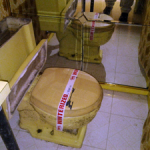Molds are very common in homes and will grow anywhere indoors where there is dampness or moisture. The most common indoor molds are Cladosporium, Penicillium, Alternaria and Aspergillius. We do not have precise information about how often Stachybotrys chartarum, sometimes known as toxic molds are found in homes. While it is less common than other mold species, it is not rare.
According to the Center for Disease Control (CDC) a common-sense approach should be used for any mold contamination existing inside homes.
 The common health concerns from molds include hay fever-like allergic symptoms. Certain individuals with chronic respiratory disease such as asthma or chronic obstructive pulmonary disorder may experience difficulty breathing. Individuals with immune suppression may be at increased risk for infection from molds. If you or your family members have these conditions, a qualified medical clinician should be consulted for diagnosis and treatment.
The common health concerns from molds include hay fever-like allergic symptoms. Certain individuals with chronic respiratory disease such as asthma or chronic obstructive pulmonary disorder may experience difficulty breathing. Individuals with immune suppression may be at increased risk for infection from molds. If you or your family members have these conditions, a qualified medical clinician should be consulted for diagnosis and treatment.
Findings according to the Institute of Medicine (IOM) show there is sufficient evidence to link indoor exposure to mold with upper respiratory tract symptoms, cough, and wheeze in otherwise healthy people; increased symptoms in people with asthma; and with hypersensitivity pneumonitis in individuals susceptible to that immune-mediated condition. The IOM also found limited or suggestive evidence linking indoor mold exposure and respiratory illness in otherwise healthy children. Again if you or a family member suffer from these conditions you should consult your physician to determine the appropriate action to take.
The CDC states the term toxic mold is not accurate.
While certain molds are toxigenic, meaning they can produce mycotoxins, the molds themselves are not toxic, or poisonous. Any hazards presented by molds that may produce mycotoxins should be considered the same as other common molds which can grow in your house. There is always a little mold everywhere. Mold is in the air and on many surfaces. There are very few reports that toxigenic molds found inside homes can cause unique or rare health conditions such as pulmonary hemorrhage or memory loss. These case reports are rare, and a causal link between the presence of the toxigenic mold and these conditions has not been proven.
Another common sense approach should be used to determine if you have a mold issue in your home.
If you have a growth that appears to be mold, then following guild lines set up by the EPA to remediate the mold issue. The next step would be to take routine measures to prevent future mold growth in the home.
What should you do when mold issues are suspected, and yet evidence of apparent mold is not seen?
It is important to choose a certified mold inspector who will do a physical inspection including attics, basements and crawl spaces. The best people qualified to do mold inspections are experienced home inspectors or an IAC2 certified mold inspector who has been trained by a licensed certified home inspector.